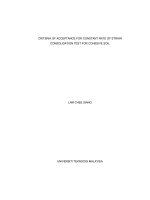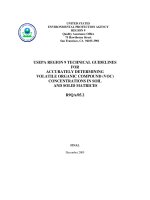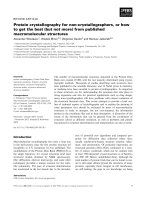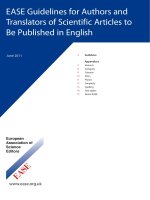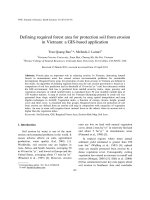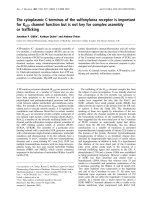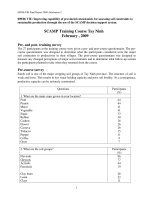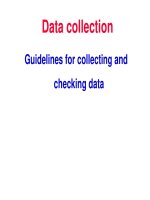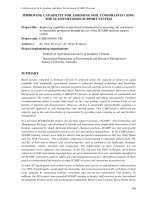Guidelines for potential soil or groundwater contamination
Bạn đang xem bản rút gọn của tài liệu. Xem và tải ngay bản đầy đủ của tài liệu tại đây (18.18 KB, 2 trang )
Guidelines for Potential Soil or Groundwater Contamination
at Proposed Project Sites
The presence of soil and or groundwater contamination at or under a proposed development site
can have significant consequences on the proposed project. Our goal is to provide you, the
developer, with guidance as early in the process as possible so that you can address any
potential concerns that arise with minimal delays to your project. Please submit written responses
to your Planning Department representative. Note that these are general guidelines and do not
address every situation.
If you have questions regarding these guidelines please contact the Acting Fire Marshal Gordon
Simpkinson at (650) 329-2347 or at
*************************************************************************************************************
I
Is there Soil or Groundwater Contamination?
1. Is there soil contamination on the site?
a. A Phase I investigation including a site inspection and review of public
agency files is often adequate to determine if soil contamination is a concern.
If the results of a Phase I investigation are positive, a Phase II investigation
may be necessary which includes the collection and analysis of soil samples
from the property. Your environmental consultant can advise you on the need
for a Phase I or Phase II investigation.
b. If soil contamination is found or suspected additional work may be required
as outlined below.
2. Is there groundwater contamination under or near the property?
a. A Phase I investigation may be adequate to make this determination as this
information should be available from
The San Francisco Regional Water Quality Control Board
(RWQCB), 1515 Clay Street, Oakland, CA. (510) 622-2300,
The State Water Resources Control Board’s Geotracker web site
at and,
The Department of Toxic Substances Control (DTSC) web site at
/>b. If groundwater contamination is found or suspected additional work may be
required as outlined below.
3. If there is no soil or groundwater contamination under or near the property submit
written confirmation to your Planning Department representative. A copy of the
consultant’s report satisfies this requirement.
II
Soil Contamination
4. If soil contamination is confirmed, submit a plan that includes the following at a
minimum. In most cases you will need the services of a qualified professional to
develop and execute the plan.
a. Proposed method to determine the scope of contamination
b. Removal of contaminated soil
c. Disposal method
d. Sampling plan to confirm all contaminated soil has been removed
Feb. 7, 2011
III
Groundwater Contamination
5
If there is or are nearby groundwater contamination plume(s) provide confirmation
from a qualified professional or the authority having jurisdiction (AHJ) whether the
plumes extend under the subject property or if they are likely to migrate under the
property. Examples of plumes that are unlikely to migrate under a subject property
include plumes that are down or cross-gradient or upgradient plumes that have
installed barrier devices such as slurry walls or extraction wells.
6
If the groundwater under the property is contaminated, then before proceeding with
the proposed project you must provide either:
a. Documentation from the AHJ that indicates the following:
i. That the contaminant types and concentrations are not a potential
threat to site development workers or future users/inhabitants of the
site.
ii. That the work proposed will not adversely impact the movement of
the plume
iii. That the work proposed will not adversely impact groundwater
cleanup activity or ongoing groundwater monitoring.
iv. That a Risk Management Plan is not necessary, or
b. Documentation
i. From the AHJ identifying the mitigating work necessary for the
proposed project to proceed, or their approval of a work plan
prepared by a qualified professional,
ii. A Risk Management Plan, if required by the AHJ, and
iii. A work plan from you prepared by a qualified professional describing
the mitigating work. Note: if acceptable to both the AHJ and the City
of Palo Alto some work may be conducted concurrently with the
project.
7
Finally, if the project work will reach groundwater depths then the Palo Alto Regional
Water Quality Plant will also want to ensure the groundwater will be disposed
properly. You will need to contact them at 650-329-2598.
Feb. 7, 2011
